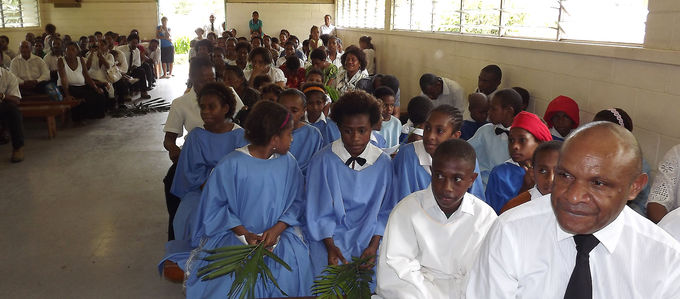
How do New Apostolic Christians in other parts of the world live their faith? Today, nac.today takes you to Papua New Guinea in the south-western Pacific Ocean.
Oceania – Papua New Guinea – Port Moresby
Papua New Guinea is an island in the north of the Australian continent. The country, including all its islands, covers 460,000 square kilometres. It is comprised of the eastern part of the island of New Guinea as well as several hundred islands in the Bismarck Archipelago and in the northern Solomon Sea. The people there speak Hiri Motu or Tok Pisin—two of the many languages that are spoken in this part of the world. Independen Stet bilong Papua Niugini is Pidgin for Independent State of Papua New Guinea. Tok Pisin serves as an effective lingua franca. Alone the Papuan peoples—the largest population group in the archipelago—are comprised of a thousand different ethnic groups. They have their own languages, cultures, laws, values, norms, and religions. Then there are the Melanesians, Micronesians, Polynesians, Chinese, and the Europeans. Some 830 languages and dialects are spoken in Papua New Guinea, comprising 15 per cent of all living languages. There is also a diversity of religions: there are many Christian denominations, Baha’is, animists, Buddhists, Hindus, and Muslims.
Port Moresby, the national capital, has a population of about 300,000, not counting the people living in the slums on the edge of the city. The 240-square-kilometre National Capital District stretches along the eastern shore of the Gulf of Papua. It is only 35 metres above sea-level. Humidity is 80 per cent and the average annual temperature is at a fairly constant 30 °C. You have to be healthy to live here. And the quality of life? According to a ranking by the Economist Intelligence Unit from the year 2012, Port Moresby is considered the second least livable city out of 140 cities worldwide. It is ranked just above Dhaka. Gang wars, corruption, and organized crime are the order of the day.
Congregations in contrast
How is the situation of our Church in the national capital? Quite good, District Apostle Andrew Andersen of Australia says. He is responsible for Papua New Guinea. The congregation in Port Moresby has more than 300 members. Actually there are two congregations: one congregation right in the city named Rainbow, and the second one just a little outside of the city called Hanuabada. This congregation is comprised of indigenous peoples from the city quarter, whereas Rainbow is more international. Rainbow Church is a solid brick structure. Hanuabada does not have a church building. The number of ministers who look after the congregations is quite sizeable. There is a Shepherd, two Evangelists, six Priests, and five Deacons.
Papua New Guinea, the District Apostle says, is a predominantly Christian country. The New Apostolic Church can practice freely. Before colonial rule, missionaries came to the islands and brought culture and education and a deep understanding of God. Papua New Guinea is a member of the Commonwealth. It is a democratic parliamentary system of government modelled after the politics of the United Kingdom, the District Apostle says. The island country gained independence as late as 1975. The New Apostolic Church was registered in 1980.
The early years were good and there was progress so that the chapel was built in Rainbow in September 1992. Jim Eyerman, a committed Evangelist from the USA, was the first to bring the teachings of the New Apostolic Church to Papua New Guinea. This was in 1977. Many missionary trips were also done by ministers from Australia. Today, the New Apostolic Christians in Papua New Guinea are cared for by the Australia District.
A very active congregation
The Rainbow congregation promotes a family-oriented environment. There is a choir made up of mostly youth, about 30–35 members, and there is a Sunday School choir of 25 children. Both groups love to make music. The singing in the divine services is accompanied by a keyboard. “Both the youth and the children are inspired to learn music as a good way of promoting what we call a sermon in song,” the District Apostle says. District Apostle Andersen hopes that the present situation can create the avenue for starting an orchestra in the near future. “Music is contagious! We believe anyone will appreciate meaningful, heartfelt, and serene music that touches the soul and spirit.”




















